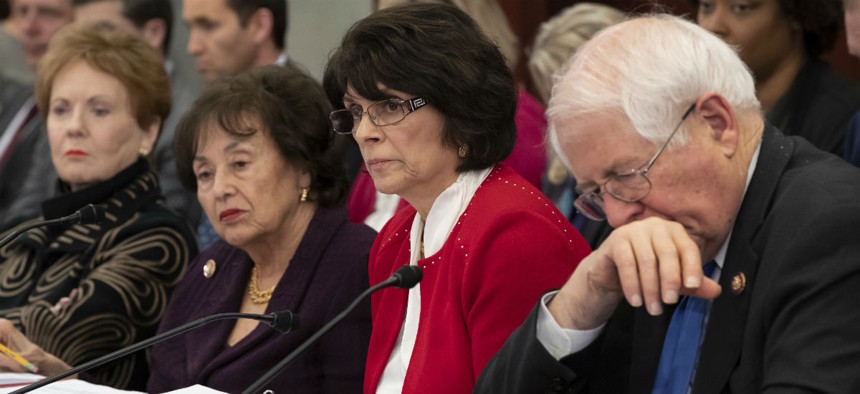Wall Funding Remains In Limbo But Both Sides Argue For Border Security Tech

From left, Reps. Kay Granger, R-Texas, Nita Lowey, D-N.Y., Lucille Roybal-Allard, D-Calif., and David Price, D-N.C., listen as a bipartisan group of House and Senate bargainers meet to craft a border security compromise to avoid another shutdown. J. Scott Applewhite/AP
Democrats and Republicans from both chambers of Congress said they want cutting-edge tech patrolling the border but GOP members of the conference committee say they want physical barrier funding, too.
House Democrats participating in the House-Senate conference negotiations on funding for the Homeland Security Department released a one-pager with their goals, which favors more funding for technology over physical barriers like a wall.
Along with 1,000 additional Customs and Border Patrol officers, House Democrats called for:
- New imaging technology at the land ports of entry to ensure all vehicles are scanned before entering the country for drugs and other contraband.
- New equipment at mail processing facilities to interdict fentanyl and other opioids shipped through the international mail.
- New cutting-edge technology along the border to improve situational awareness.
- An expansion of CBP’s air and marine operations along the border and in U.S. waters.
While not explicitly called out in the release, the last item could refer to Border Patrol’s drone program, which is under the Air and Marine Operations office.
What the proposal doesn’t include is a wall.
“We will be pushing for a strong, but smart, border security posture, one that does not rely on costly physical barriers,” Rep. Lucille Roybal-Allard, D-Calif., chairwoman of the House Appropriations Homeland Security Subcommittee, said in a statement along with the Democrats’ proposal.
To achieve that, funding would need to be spread across multiple areas, she said.
“Democrats support homeland security, including border security, that is smart, effective, and consistent with our core values as Americans,” Roybal-Allard said. “I look forward to working with my colleagues to reach an agreement.”
Republican conferees in the House and Senate agreed, though leaders from both chambers told the conference Wednesday that funding for physical barriers should be included.
“Smart technology is part of a comprehensive solution, but it is not the solution in and of itself,” said Senate Appropriations Chairman Richard Shelby, R-Ala., who is serving as vice-chair of the conference committee. “Cameras, sensors, drones and other smart technology highlight the gaps and vulnerabilities along our border. In short, they provide a greater awareness of exactly where our insecurities lie along the border.”
However, he said, technology won’t physically stop someone from crossing the border.
That said, the wall doesn’t need to stretch “from coast to coast,” Shelby argued, “but strategically placed where traffic is highest.”
“Combined with technology, manpower, and other infrastructure, these strategic barriers comprise a comprehensive solution that is capable of fully securing the border,” he said.
Kay Granger, R-Texas, ranking member of House Appropriations, similarly balanced the need for tech with the need for physical security.
“I am optimistic that we will be able to reach agreement in support of the things experts on the border have said they need in order to secure our homeland and address the crisis we face,” she told the conference, citing, “increased funding for technology, canines and personnel to help stop flow of illegal drugs, weapons and other contraband,” and “resources to implement smart technology and barriers where Border Patrol experts have said they would be most impactful.”
Either way, technology should—and likely will—be a major part of the final funding bill, according to Mike Hettinger, founder of the Hettinger Strategy Group and former House Oversight staff director.
“Technology has to be part of any effective border security solution,” he told Nextgov. “New technologies like drones and infrared scanners, coupled with more effective use of data and analytics can help the U.S. government gain a more complete picture of what’s happening at the border and in turn allow us to deploy resources more efficiently.”
“Security technologies have evolved quickly and significantly over the last five years,” he added. “They should be put to use on the border.”
Members of the conference have little more than two weeks to come to an agreement that can pass the House and Senate and get President Trump’s signature before short-term funding runs out again on Feb. 15.






